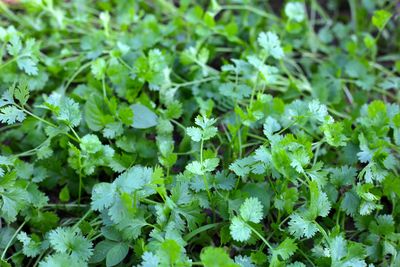Introduction
- Cilantro, also known as coriander, is a fast-growing annual herb prized for its fresh leaves and seeds. It’s a cool-season crop that grows best in Santa Clara County from fall through spring. While it’s famous for bolting quickly in warm weather, careful timing and successive sowing can give you a steady harvest. Both the leaves (cilantro) and the seeds (coriander) are useful in cooking, making it a versatile addition to any garden.
Quick Facts
- Type: Annual herb
- Height: 12–24 inches tall
- Harvest Season: Fall, winter, and spring
- Sun Requirements: Full sun in cool months; light afternoon shade in spring
- Soil Type: Loose, well-draining soil rich in compost; pH 6.2–6.8
- Water Needs: Moderate; keep soil evenly moist but not waterlogged
Planting Guide
When to Plant
- Direct seed only—cilantro has a long taproot and doesn’t transplant well.
- Fall crop: September–November (ideal for leaf harvest)
- Winter crop: December–January (slower growth but still productive)
- Spring crop: February–March (shorter harvest window before bolting)
- Avoid planting in summer—heat and long days cause rapid flowering.
Where to Plant
- Full sun in fall/winter; light afternoon shade helps in spring.
- Works well in raised beds and deep containers (at least 8–10″).
- Plant near spinach, lettuce, or dill for a productive cool-season herb bed.
How to Plant
- Seeds: Sow ¼ inch deep and 1–2 inches apart; thin seedlings to 4–6 inches apart.
- Soil prep: Mix compost into the soil before planting. Cilantro prefers fertile, moisture-retentive ground.
- Watering: Keep soil evenly moist for germination (7–10 days).
Care & Maintenance
- Watering: Regular watering is key; dry soil speeds up bolting.
- Fertilizing: Apply a light side-dressing of compost or liquid organic fertilizer every 3–4 weeks.
- Bolting: Cilantro naturally bolts as days lengthen. Plant in succession every 3 weeks for a longer harvest.
- Pests & diseases: Aphids and leaf miners are common in Santa Clara County. Aphids can be controlled with insecticidal soap or by encouraging beneficial insects.
Harvesting
- Begin harvesting when plants are 6 inches tall. Snip outer leaves, leaving the center to keep producing.
- For coriander seeds, allow flowers to set seed heads. Harvest when seeds turn brown and dry on the plant.
- Regular picking delays bolting and keeps plants leafy longer.
Lifecycle & Reseeding
- Cilantro is a short-lived annual but reseeds readily.
- If allowed to flower and set seed, you’ll often find volunteer plants after the rainy season.
Wildlife & Companion Benefits
- Cilantro flowers are highly attractive to pollinators and beneficial insects like hoverflies, lacewings, and parasitic wasps.
- Good companion for spinach, lettuce, and dill.
- Avoid planting too close to fennel, which competes strongly.
Extra Tips
- For longer harvests, grow cilantro in partial shade as spring warms up.
- Use succession planting from fall through spring to maintain a steady supply.
- Choose slow-bolting varieties (like Santo) if planting in early spring.
- Let a few plants flower—both for pollinators and for collecting coriander seed.
Where to Get Seeds
